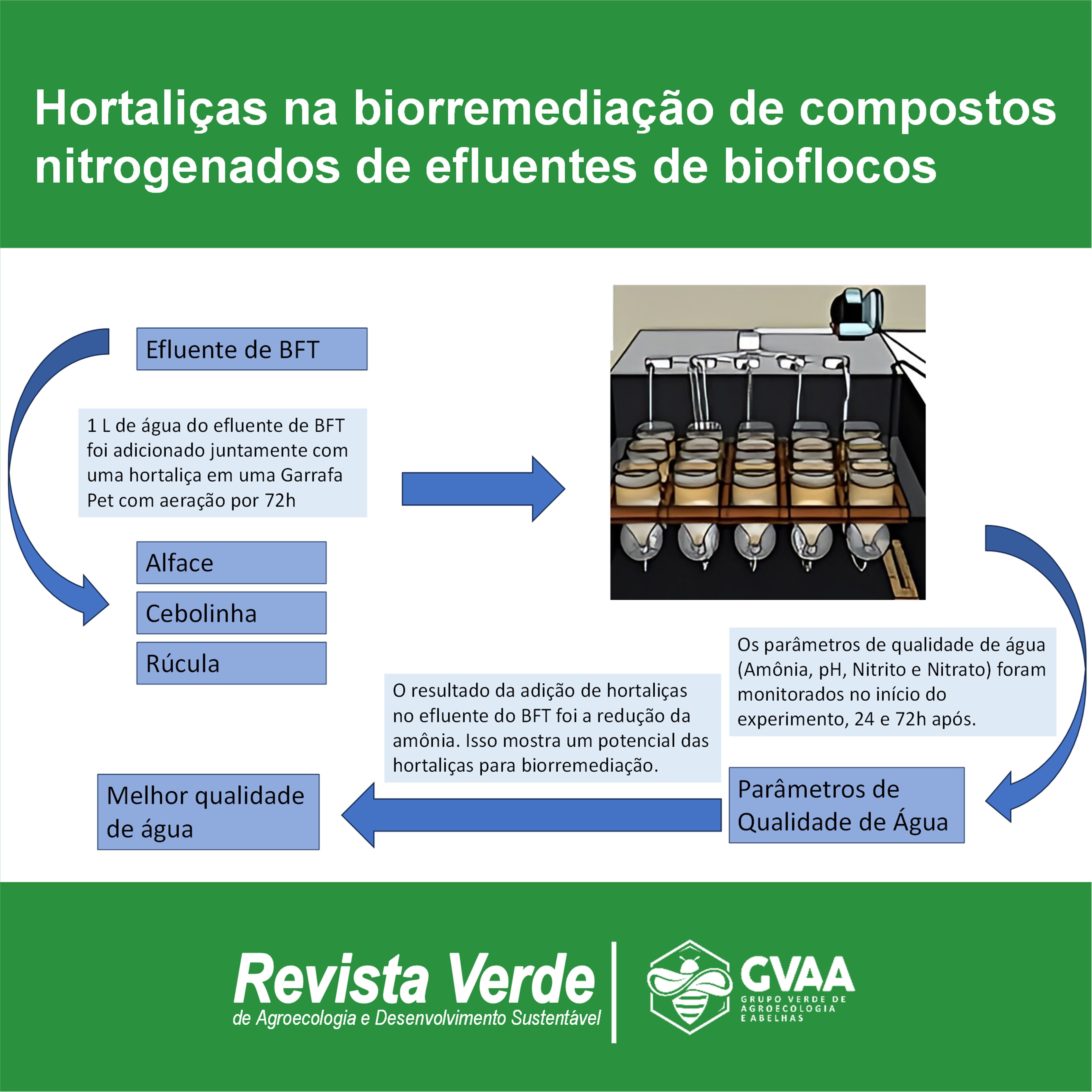Vegetales en la biorremediación de compuestos nitrogenados de efluentes de biofloc
DOI:
https://doi.org/10.18378/rvads.v19i1.9832Palabras clave:
Amoníaco, Acuicultura, Nitrito, Nitrato, NitrificaciónResumen
Nuestro trabajo tiene como objetivo evaluar los cambios en los parámetros de calidad del agua del efluente de un sistema de biofloc (BFT) después de la inserción de vegetales. Se utilizaron plántulas de hortalizas de tres especies: lechuga (Lactuca sativa), rúcula (Eruca sativa) y cebolla de verdeo (Allium schoenoprasum). Se utilizaron doce frascos de tereftalato de polietileno, divididos en cuatro grupos (tres vegetales diferentes y control), por triplicado, equipados con un sistema de aireación (individualmente) para evitar la sedimentación de BFT. Las botellas se mantuvieron en una caja de polietileno (180L). Las botellas se llenaron con 1 L de agua BFT utilizada como muestra inicial (tiempo cero). Se midió el pH, amoníaco total, nitrito y nitrato en el tiempo cero, 24 horas y 72 horas después de la inserción de los diferentes vegetales en el sistema experimental. Fue posible observar mejoras significativas en los niveles de amoníaco 24 h después de la inserción de los vegetales, ya que los tratamientos (Lechuga, Cebollín y Rúcula) redujeron la cantidad de amoníaco en comparación con el grupo control. Sin embargo, hubo poca influencia en el pH, nitrito y nitrato. Por tanto, podemos concluir que la inserción de vegetales en el efluente reduce los niveles de amoníaco, mejorando los parámetros de calidad del agua y, por tanto, puede reducir el impacto ambiental o actuar como biorremediadores del entorno de cultivo.
Descargas
Citas
BOYD, C. E. Water quality: an introduction. Springer Nature, 2019.
EMERENCIANO, M.; GAXIOLA, G.; CUZON, G. Biofloc technology (BFT): a review for aquaculture application and animal food industry. Biomass Now-Cultivation and Utilization. Miodrag Darko Matovi Intech Open. InTech, Croatia, 2013. DOI: https://doi.org/10.5772/53902
EMERENCIANO, M.; MARTÍNEZ-CÓRDOVA, L. R.; MARTÍNEZ-PORCHAS, M.; MIRANDA-BAEZA, A. Biofloc technology (BFT): a tool for water quality management in aquaculture. In: Tutu H, editor. Water Quality. London (UK). 10.5772/66416
ESTRADA‐PEREZ, N.; HERNANDEZ-LLAMAS, A.; RUIZ-VELAZCO, J. M. J.; ZAVALA-LEAL, I.; ROMERO-BAÑUELOS, C. A.; CRUZ-CRESPO, E.; JUÁREZ-ROSSETE, C.; DOMÍNGUEZ-OJEDA, D.; CAMPOS-MENDOZA, A. Stochastic modelling of aquaponic production of tilapia (Oreochromis niloticus) with lettuce (Lactuca sativa) and cucumber (Cucumis sativus). Aquaculture Research, v. 49, n. 12, p. 3723-3734, 2018. 10.1111/are.13840 DOI: https://doi.org/10.1111/are.13840
ENDUT, A.; JUSOH, A.; ALI, N. A.; WAN NIK, W. B. Nutrient removal from aquaculture wastewater by vegetable production in aquaponics recirculation system. Desalination and water treatment, v. 32, n. 1-3, p. 422-430, 2011. 10.5004/dwt.2011.2761 DOI: https://doi.org/10.5004/dwt.2011.2761
FINK, M.; FELLER, C. An empirical model for describing growth and nitrogen uptake of white cabbage (Brassica oleracea var. capitata). Scientia horticulturae, v. 73, n. 2-3, p. 75-88, 1998. 10.1016/S0304-4238(97)00154-4 DOI: https://doi.org/10.1016/S0304-4238(97)00154-4
HU, Z.; LEE, J. W.; CHANDRAN, K.; KIM, S.; BROTTO, A. C.; KHANAL, S. K. Effect of plant species on nitrogen recovery in aquaponics. Bioresource technology, v. 188, p. 92-98, 2015. 10.1016/j.biortech.2015.01.013 DOI: https://doi.org/10.1016/j.biortech.2015.01.013
JATOBÁ. A.; BORGES, Y.V.; SILVA, F.A. BIOFLOC: sustainable alternative for water use in fishculture. Arquivo Brasileiro de Medicina Veterinária e Zootecnia, 71, 3, 1076-1080, 2019. 10.1590/1678-4162-10309 DOI: https://doi.org/10.1590/1678-4162-10309
JATOBÁ, A.; STOCKHAUSEN, L.; SILVA, L. R.; ANDRADE, J. I. A. Therapeutic bath of mint hydrolate in the control of monogenea for four tilapia species. Boletim do Instituto de Pesca, v. 49, 2023. 10.20950/1678-2305/bip.2023.49.e706 DOI: https://doi.org/10.20950/1678-2305/bip.2023.49.e706
KOTZEN, B.; EMERENCIANO, M.; MOHEIMANI, N.; BURNELL, G. M. Aquaponics: Alternative types and approaches. Aquaponics food production systems: Combined aquaculture and hydroponic production technologies for the future, p. 301-330, 2019. 10.1007/978-3-030-15943-6_12 DOI: https://doi.org/10.1007/978-3-030-15943-6_12
MARTINEZ-CORDOVA, L. R.; LÓPEZ-ELÍAS, J.; MARTINEZ-PORCHAS, M.; BRINGAS-BURGOS, B.; NARANJO-PARAMO, J. A preliminary evaluation of an integrated aquaculture-agriculture systems (tilapia and peppers) at mesocosm scale. J Aquac Mar Biol, v. 9, n. 1, p. 19-22, 2020. 10.15406/jamb.2020.09.00272 DOI: https://doi.org/10.15406/jamb.2020.09.00272
OLSSON, M. O.; FALKENGREN, U. G. Potential nitrification as an indicator of preferential uptake of ammonium or nitrate by plants in an oak woodland understorey. Annals of Botany, v. 85, n. 3, p. 299-305, 2000. 10.1006/anbo.1999.1075 DOI: https://doi.org/10.1006/anbo.1999.1075
PINHO, S. M.; DE LIMA, J. P.; TARIGAN, N. B.; DAVID, L. H.; PORTELLA, M. C.; KEESMAN, K. J. Modelling FLOCponics systems: Towards improved water and nitrogen use efficiency in biofloc-based fish culture. Biosystems Engineering, v. 229, p. 96-115, 2023. 10.1016/j.biosystemseng.2023.03.022 DOI: https://doi.org/10.1016/j.biosystemseng.2023.03.022
READ, P.; FERNANDES, T. Management of environmental impacts of marine aquaculture in Europe. Aquaculture, v. 226, n. 1-4, p. 139-163, 2003. 10.1016/S0044-8486(03)00474-5 DOI: https://doi.org/10.1016/S0044-8486(03)00474-5
SUMITRO, T. B.; FAUZI, H.; EKASARI, J. Production performance and nitrogen and phosphorus mass balance in biofloc-based African catfish intensive culture at different densities. Jurnal Akuakultur Indonesia, v. 20, n. 1, p. 82-92, 2021. 10.19027/jai.20.1.82-92 DOI: https://doi.org/10.19027/jai.20.1.82-92
VINATEA-ARANA, L. Princípios químicos de qualidade da água em aqüicultura. Florianópolis: Editora da UFSC, 1997.
WU, Y.; DUAN, Y.; WEI, Y.; AN, D.; LIU, J. Application of intelligent and unmanned equipment in aquaculture: A review. Computers and Electronics in Agriculture, v. 199, p. 107201, 2022. 10.1016/j.compag.2022.107201 DOI: https://doi.org/10.1016/j.compag.2022.107201
ZHOU, X.; WANG, J.; HUANG, L.; LI, D.; DUAN, Q. Modelling and controlling dissolved oxygen in recirculating aquaculture systems based on mechanism analysis and an adaptive PID controller. Computers and Electronics in Agriculture, v. 192, p. 106583, 2022. 10.1016/j.compag.2021.106583 DOI: https://doi.org/10.1016/j.compag.2021.106583

Descargas
Publicado
Cómo citar
Número
Sección
Licencia
Derechos de autor 2023 Samantha Heiderscheidt et al.

Esta obra está bajo una licencia internacional Creative Commons Atribución 4.0.
Datos de los fondos
-
Conselho Nacional de Desenvolvimento Científico e Tecnológico
-
Fundação de Amparo à Pesquisa e Inovação do Estado de Santa Catarina
Números de la subvención 2021TR000638










